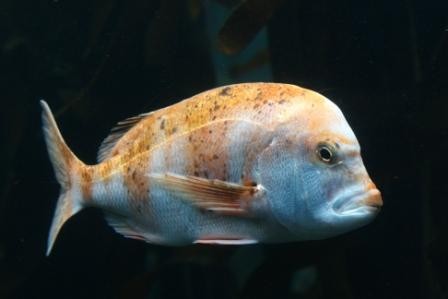Ask anybody who has been to Cape Town, and their opinion of it. Awesome, fantastic, I drank loads of wine, seem to be common comments. It’s difficult to describe the beauty of the majestic mountains which loom over the city, and put into a few words the magic of the oceans which roll about her beaches and rocks.
I say oceans in plural, as Cape Town has two ocean currents which run past it. The warm Agulhas runs south and west from the Indian Ocean pushing against the near-freezing waters of Antarctica, before meeting the cold Benguela current off the Cape of Good Hope. The second swiftest current in all the world’s oceans, the Agulhas is deadlier than the swiftest current (the Gulf Stream) for two reasons. First one of its branches surges through a narrow passageway between Madagascar and Mozambique on the east coast of South Africa. Furthermore its waters rush from north to south–the opposite direction from which Portuguese ships needed to travel in order to round the tip of Africa. The Atlantic side is very cold water, reaching nearly 6degC in winter. False Bay is a little warmer, with temperatures up to 22 deg C making it an ideal playground for the famous Great White Sharks that roam the waters of the Cape coast. At L’Agulhas, the Atlantic and Indian Ocean meet together and the Cape coast is fiercely rough, jagged, shallow and is, and has been, be a sailor’s nightmare. The Cape Coast is dotted with 1000s of wrecks, some inaccessible to the regular diver.
I decided to go to Cape Town to see if I could see the white sharks and other sharks on a friend’s blue water hunting expeditions, but unfortunately as I hit the Cape the rough weather joined me and I was limited to diving in False Bay, which proved to have other attractions. I signed up with Scuba Shack who are based close to Kommetjie, and embarked on my first ever dive in South African waters.
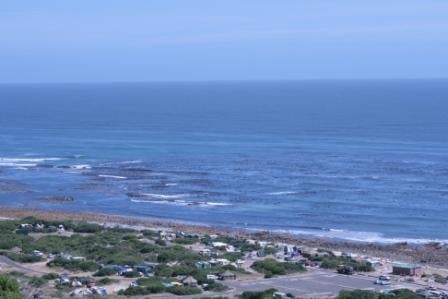
False Bay
As you drive from Cape Town centre towards Kommetjie, you can choose two routes, over the mountain or around the coast. I chose to go the coastal route, past Chapmans Peak. You can appreciate the dramatic coastline on the way, stop off at look outs, see baboons running around the cliffs, and if you are there during whale season it is often that you will see them from the shore. At that time of the morning, the swell was reaching 3 metres and it did not look promising. I arrived at Scuba Shack at 07.15am, it was cold, raining, and rough. They made a couple of phone calls and it seemed that on the other side of the mountain, close to Simonstown in False Bay the diving conditions were reasonable. We arrived shortly afterwards and I was greeted by a massive blue bay of small white capped waves and the sun pushing its way through the clouds. We assembled our kit in the parking lot and placed it all into a large rubber duck (rib) and set on our way. It was a little rough but a fun ride and we set on towards a wreck called the Transvaler, which lies in 34m of water. I was wearing an Imersion 7mm open cell farmer john, with a 7mm jacket with hood, 3mm neoprene socks under my 3mm sea boots, my trusty S-tek harness and Scubapro regs, gloves and to be honest, an apprehensive smile.
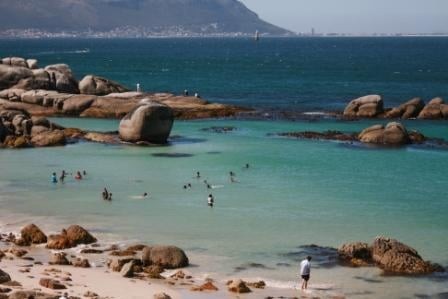
False Bay is riddled with White sharks, and the dive briefing clearly said “do not waste time on the surface”. Those words haunted me as we all rolled over backwards and all I could think about was rolling on to the back of a big shark who had not yet had breakfast. We descended quickly down a shot line and the vis was about 3 metres. My assigned dive buddy was a novice diver, so I concentrated on her, leaving all thoughts of Jaws behind me on the surface. As we approached about 20 metres depth, the visibility cleared up and it was about 7 metres clear ahead. I was truly astonished how beautiful it was. The finger sponges, sea stars, nudibranches, all different colours of red and orange were wrapped around the wreck like a blanket. It was beautiful.
The water however was a complete shock to my system, as it was 10degC, which is the coldest water I have ever dived in and after years of being a tropical cocktail diver I never felt so alert, awake, and alive, under water. The cold water touched my face like a ice-cube being rubbed on me as a joke. It almost burned. My wetsuit remained faithfully warm, but after 10 minutes, I realised that my gloves were way too thin. I battled to hold the camera and even press the button. After 20 minutes of bottom time we commenced our ascent, on my part extra slow due to the coldness of the water and also the depth of the dive. When we reached the surface I was unable to use my hands. The rib approached us telling us to remove our weight belts quickly and get our gear off as quickly as possible, and get in the boat. I was totally useless. I had no feeling in my hands and could not even move fast. My body had slowed down completely which are signs of first stages of hypothermia.
Fortunately another diver, Duncan and his dive partner Elsa assisted me to remove my gear. They were kitted up in dry suits and I’ll tell you all what, next time I dive in Cape Town I will certainly invest in one! I giggled nervously as I knew I was “wasting time” on the surface, couldn’t get my gear off and probably looked like a novice myself. The boat captain said not to worry, as it takes at least 20 minutes of messing on the surface before the sharks become interested.
Partridges
The second dive was at a site called Partridges, and this time, I borrowed some 5mm gloves in which I wore over my regular gloves, and in spite of the holes in them, it helped a little. Partridges is a huge rock formation surrounded by kelp, sponges, seals, birds, and has beautiful swim throughs. The only problem was that we were 11 divers for the second dive and it turned out to be a small nightmare, especially when a large swell that came up and the visibility suddenly changed to about 2 metres in the last minute. One diver shot to the surface but I was not going to risk saving him as I had my buddy to look after who was having buoyancy problems with the swell, and the diver who’s buddy shot to the surface simply watched him go. The instructor did not seem to notice, and then with the decreasing vis, I could not get his attention. It was then my decision to look after self first and also my dear Swedish dive buddy, Anna.
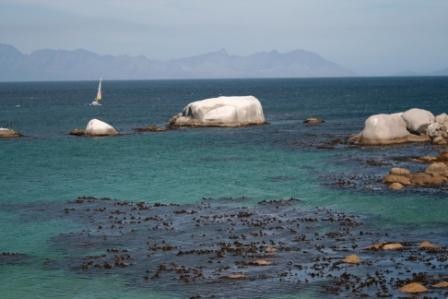
However, during the dive I saw about 20 different species of nudibranch, and at least six different variations of sponges. The colours are exhilarating! I also found a live shark’s egg (mermaid’s purse) which had become detached from where the mother had left it and it was rolling around in the sand with the swell. Once the vis clouded over we lost sight of the group, but without fear just followed the reef and then found some divers who could not understand our hand signals. I believe one of them was the instructor (couldn’t see!) and when he asked me how much air I had I told him, he couldn’t understand and seeing my pressure gauge in PSI confused him even more. He released his SMB and ascended. The other divers, somewhat bewildered, ascended with Anna and I. We waited about 10 minutes on the surface to get picked up, as divers had popped up everywhere, and those words of the 20 minute surface margin before a shark appears was forever in my mind. Anyway, Anna and I kept smiling and just held on to each other in the swell, waiting our precious turn.
Diving Cape Town
Diving Cape Town is truly extraordinary! I did notice however that certain safety aspects are a little different to other countries. My dive buddy was allowed to dive with no computer, she wasn’t sure if she had a depth gauge on her rental equipment and certainly did not follow the bottom time on a time piece. Her instructions were to follow the instructor, who was doing the deep dive training dive with one student, who she took to 34 metres, which is four metres beyond the allowed depth for that dive. I followed the instructor as I am unfamiliar with the dive site and kept my dive buddy close. All the rules being broken were certainly ringing in my head…. Other pleasure divers came to me after the second dive, and asked me for the dive profile, as they too were not wearing computers, did not know to what depth we had dived, and said the diving is a little different in Cape Town, we just follow in the instructor, use dive tables kindof, and sometimes watches and “sommer net” (which means something like “just because”.) If you are diving PADI tables you should be adding another 4m to your profile when diving in cold water, so in my humble opinion, the profiles dived where way out of the safety margin. However, the dive shop itself was very presentable with Scubapro rental gear in good condition, and a very professional reception desk. They advertised PADI instruction and had a decent retail section. The instructors were friendly and polite, didn’t smoke and were helpful and getting gear on and off board. I went home delighted with my first experience in the cool waters of the fairest Cape.
The weather worsened that afternoon, and my plans for a cage dive in Gaansbaai were thwarted.
Two Oceans Aquarium
However, if you want to dive close up and personal with sharks in Cape Town, and the weather is too bad to dive, there are other options. The Two Oceans Aquarium, based at the V&A Waterfront in Cape Town, has two tanks in which divers can dive, one is a kelp forest and the other is a shark tank. I decided to do both dives just for the experience.
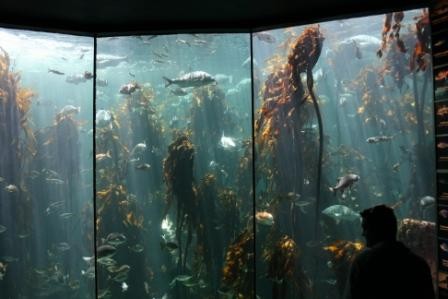
The kelp tank is a small dive, enough for two/three divers only, and has kelp wafting around with all the typical fish one would find in a kelp forest including the cute little pyjama sharks. The temperature is cold, 16 deg C although that felt warm in comparison to my dive in False Bay the previous day! The shark tank is a separate environment, with 20 deg C water and no aquatic plants, and is full of stingrays, eagle rays, bat rays, and three ragged-tooth (grey nurse) sharks. There is also one huge turtle which looks about 100 years old, by its size, and he is slow, deliberate, and very cute. The predator tank, as it is called at the aquarium contains 2 million litres of seawater and is only 5 metres deep.
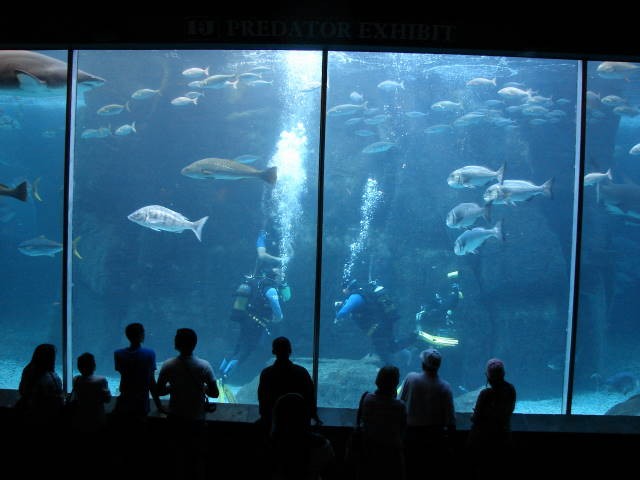
I was fortunate to be accompanied that day by Jeff Ayliffe, who is also a DeeperBlue.net contributor and writer. He was kind enough to take pictures of the dives from the outside of the tank. It was funny to see the world from within the fish bowl, especially the faces of the kids who looked at the sharks in absolute awe. I would not like to know what those fish think about us humans standing there pointing and gaping.
The Two Oceans Aquarium also has baby ragged-tooth sharks in a separate tank, an array of local South African marine life from clown fish to Knysna seahorses. The Aquarium also supports the Southern African Sustainable Seafood Initiative (SASSI) programme, and all the fish are colour coded according to which are more sustainable choices. For more information, visit www.wwf.org.za/sassi or send an email to sassi@wwf.org.za. The Victoria and Albert waterfront is enormous and sports great shops and restaurants, boat charters and you can also see seals very closely and watch them basking in the warm African sun.
Enough about diving.. where should one stay in Cape Town? I was lucky to have the fantastic hosting of DeeperBlue.net contributors Blue Water Hunter and Titan of Tuna Ismail (Miles) Sonday and his wife Zuraida (Dr. Fish, spearo and chef extraordinaire) for the first few days, and for my last night I stayed in the Dolphin Inn. I would recommend the Dolphin to anyone who wants to stay comfortably in Cape Town without paying exorbitant prices. The Dolphin Inn is on Mouille (Mussel) Point, and you can sit in the lounge and watch the break waves on the rocks until your heart’s content. The rooms are clean and correctly furnished, with an African style and feeling, and breakfast is made by the most excellent Mthetheleli Mngwandi (now say his name with a hangover), who is from the Transkei and has been living in Cape Town for ten years. He greeted me with a beautiful smile accompanied by huge fresh croissants and coffee, bacon, eggs and toast which he whisked up for the guests with the agility of Gordon Ramsay. The website for Dolphin Inn Guesthouse is www.dolphin-inn.co.za.
The Cape Province also boasts fine cuisine. The Capetonians are a rich heritage of Dutch, French, Indian, Malay and English and their fare on offer is like no other. If seafood platters are your utmost, try the Ocean Basket restaurants for good value for money, their platters are hearty and absolutely delicious, or if you want to splash out a little more and be amused by watching the snob brigade of Cape Town in a very “be-seen” restaurant, try the Wakame restaurant, just on the corner from the Dolphin Inn. The food is fantastic, the atmosphere is great and I personally was very entertained by mere people watching. The Wakame is on the first floor, below them is a fantastic delicatessen which makes great sandwiches, sells all the Mediterranean cold meats, pasta, panettone, and the coffee is great.
Flights to Cape Town from Johannesburg are many. South African Airways has a few flights daily, (I would not recommend them as their standards are not consistent, my diving gear flew free of charge on the way down and they surprised me with a 300 ZAR surcharge on the way back) – also they seem to have many delays and the staff attitude is not brilliant. You also get a horrible sandwich snack that I would not feed to a stray animal and most definitely do not bother with paying for a business class seat as they are not much different to economy class. Try www.kulula.com or the new http://ww5.flymango.com/ airlines and you can get cheaper deals as well.
For more information on diving in South Africa or any other contact details you would like to get, don’t hesitate to email me at sara.haith@deeperblue.net.
Safe bubbles till next time, and all the best for a prosperous 2007.
